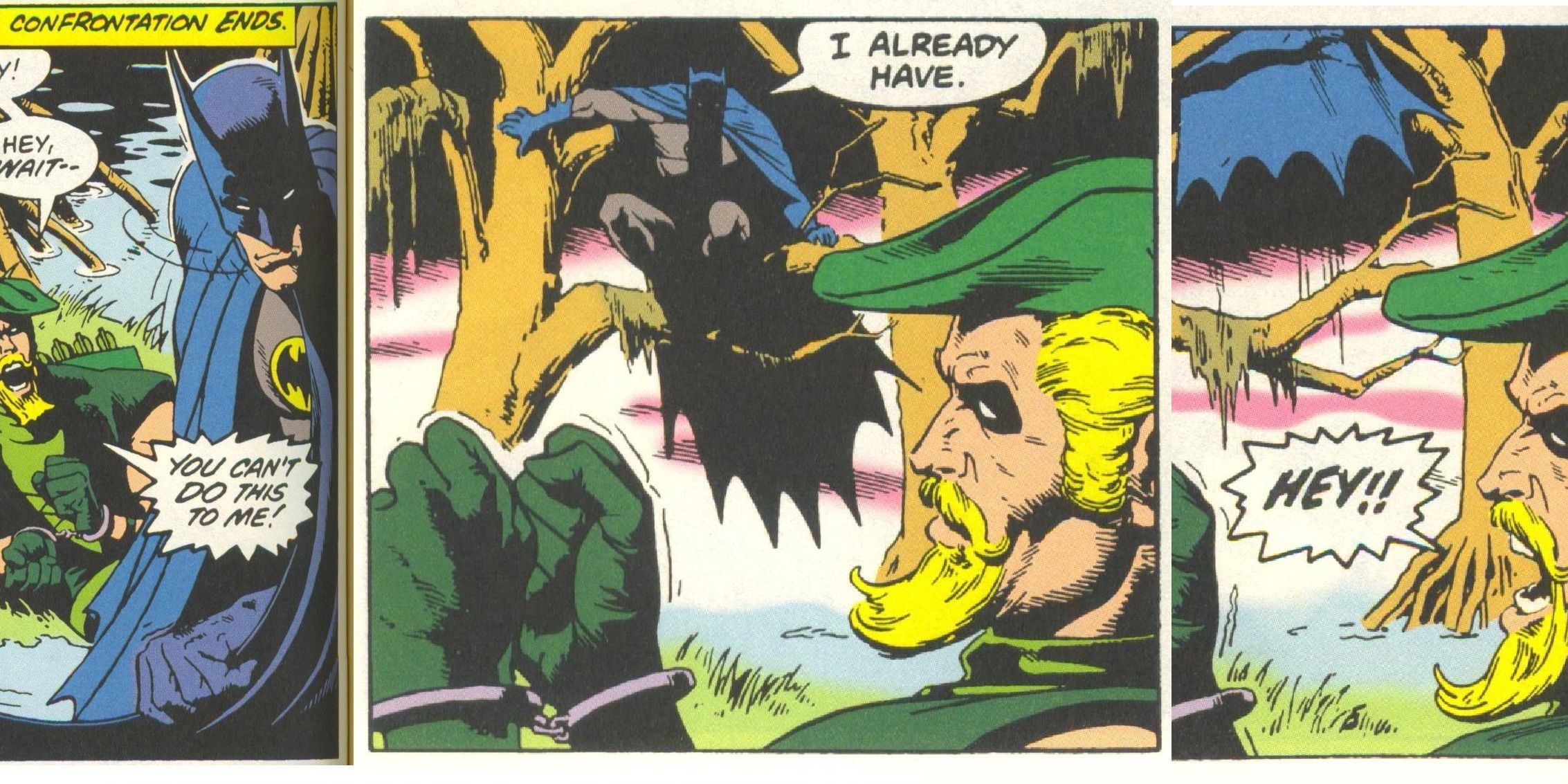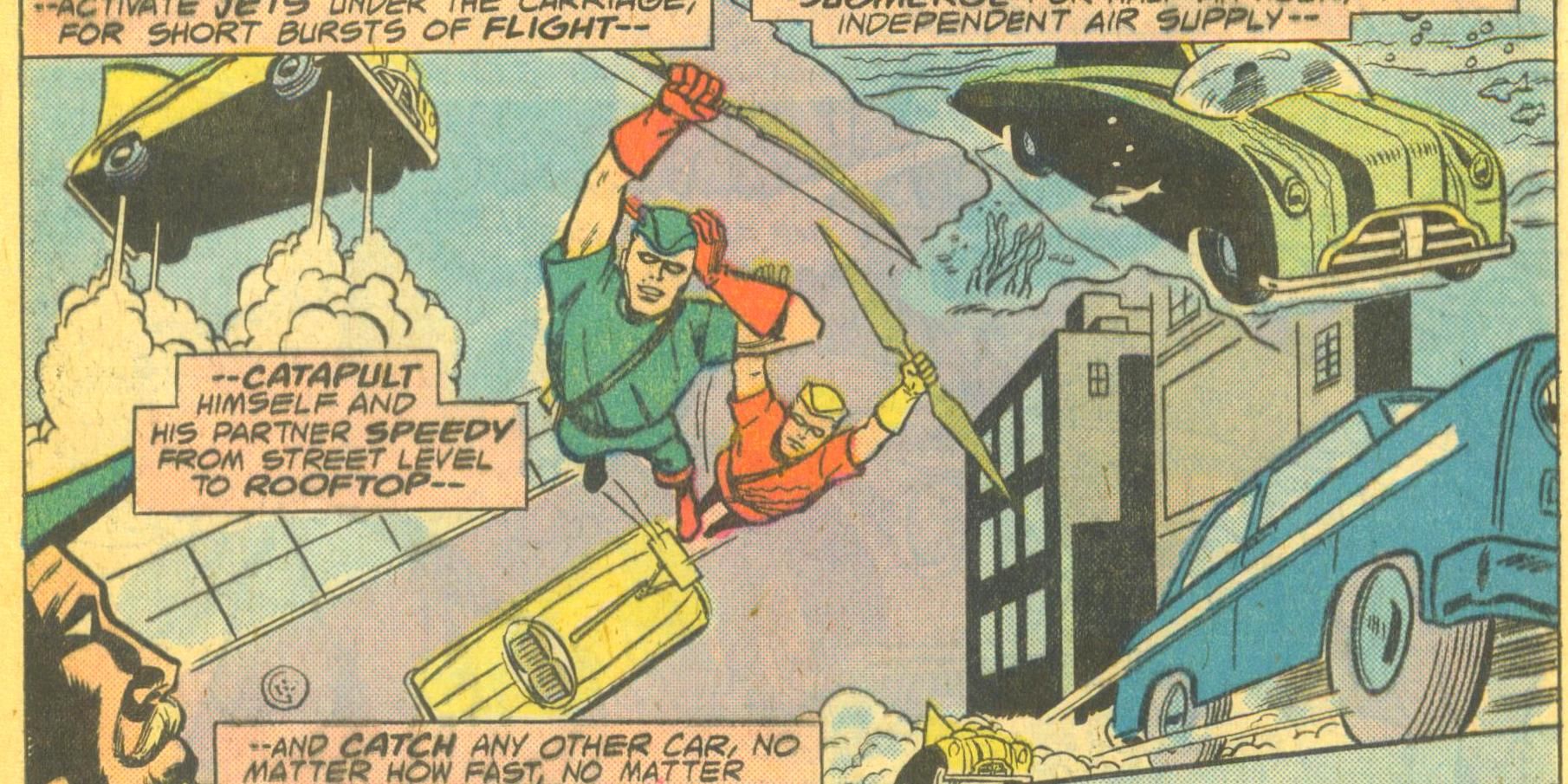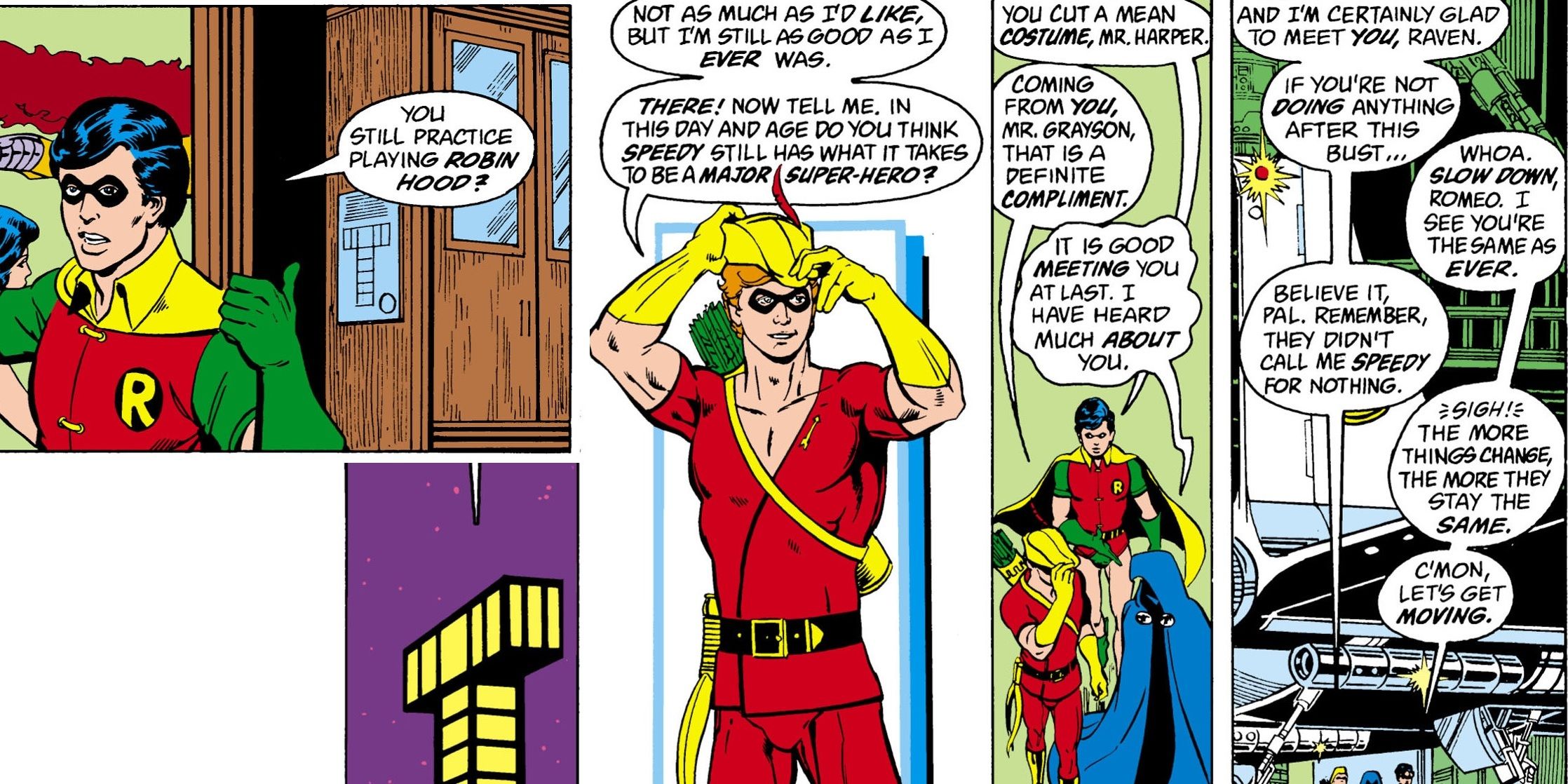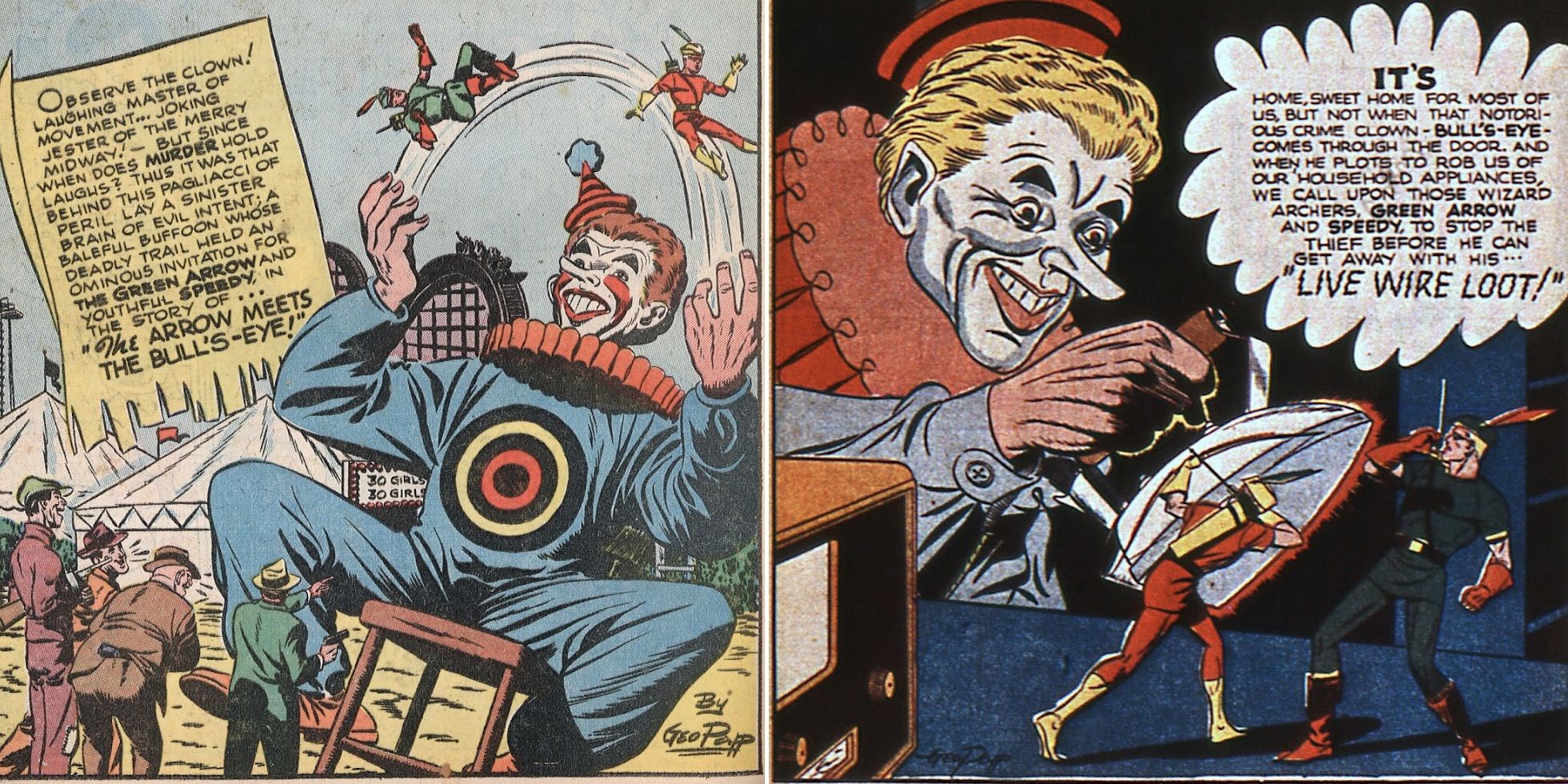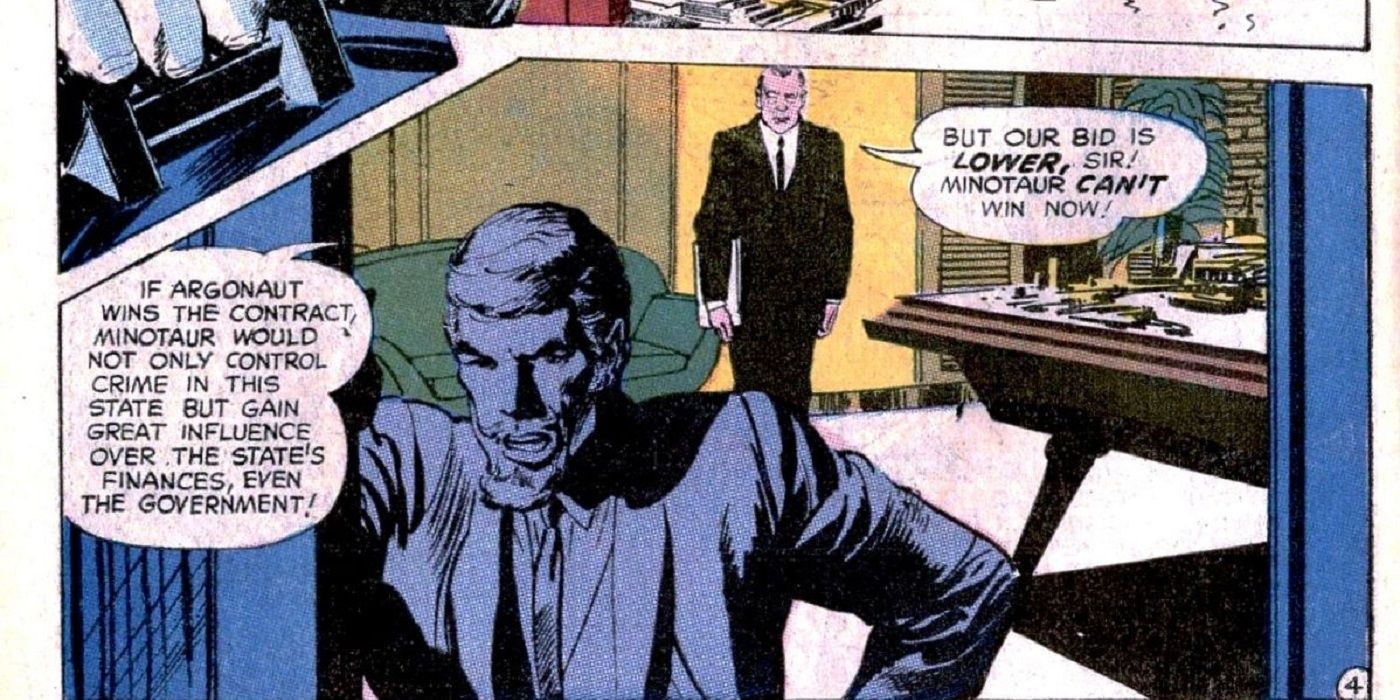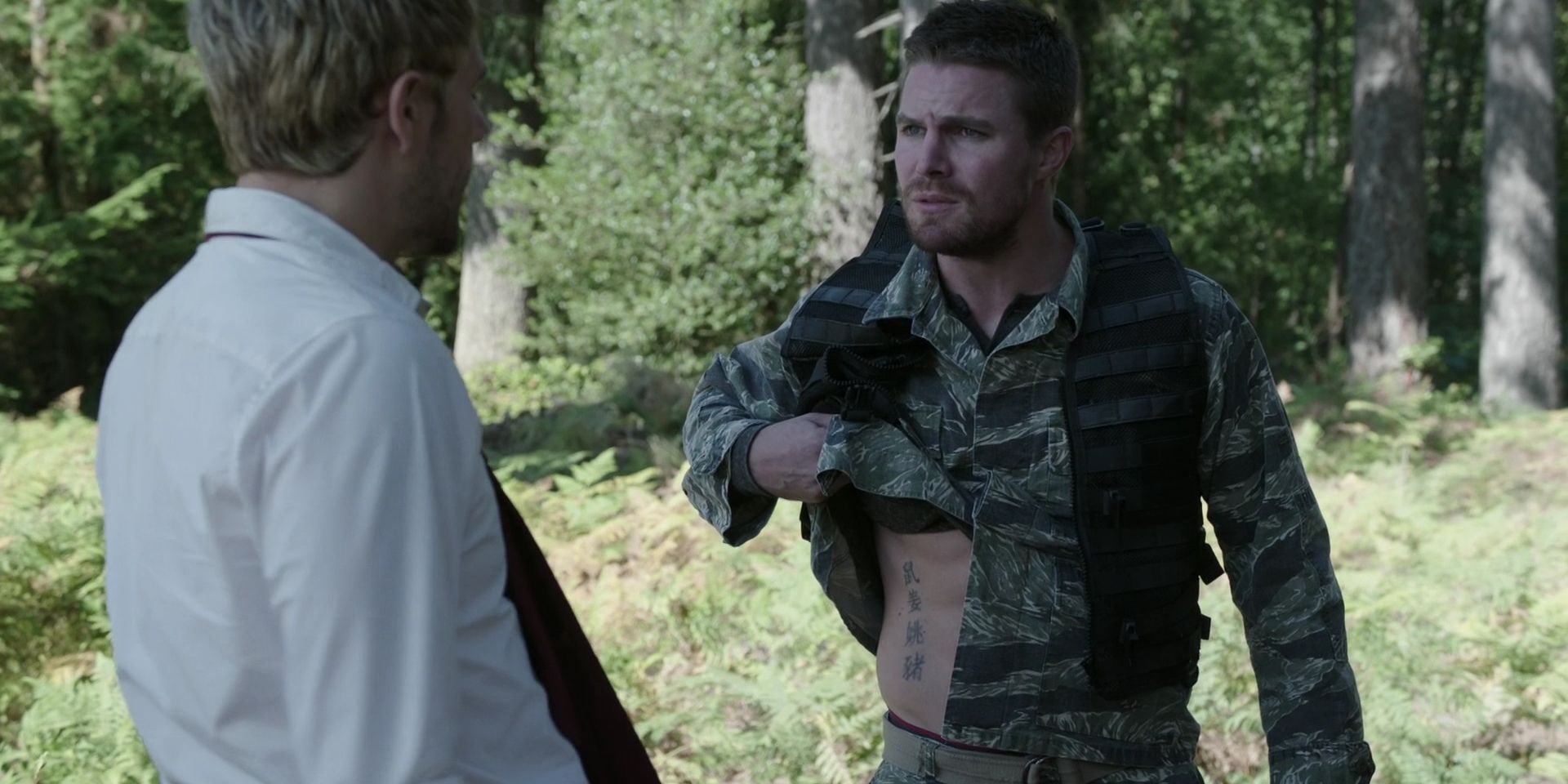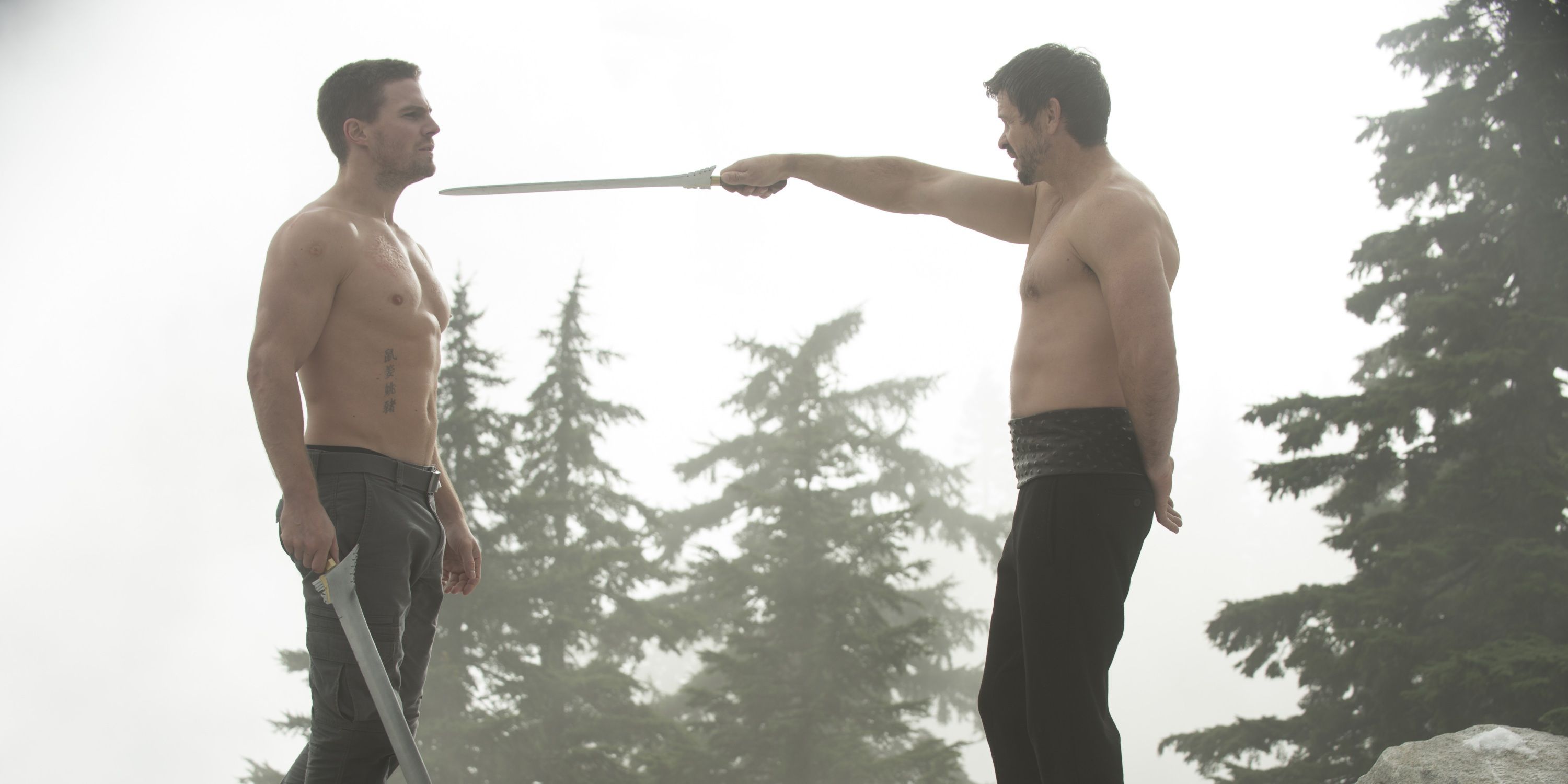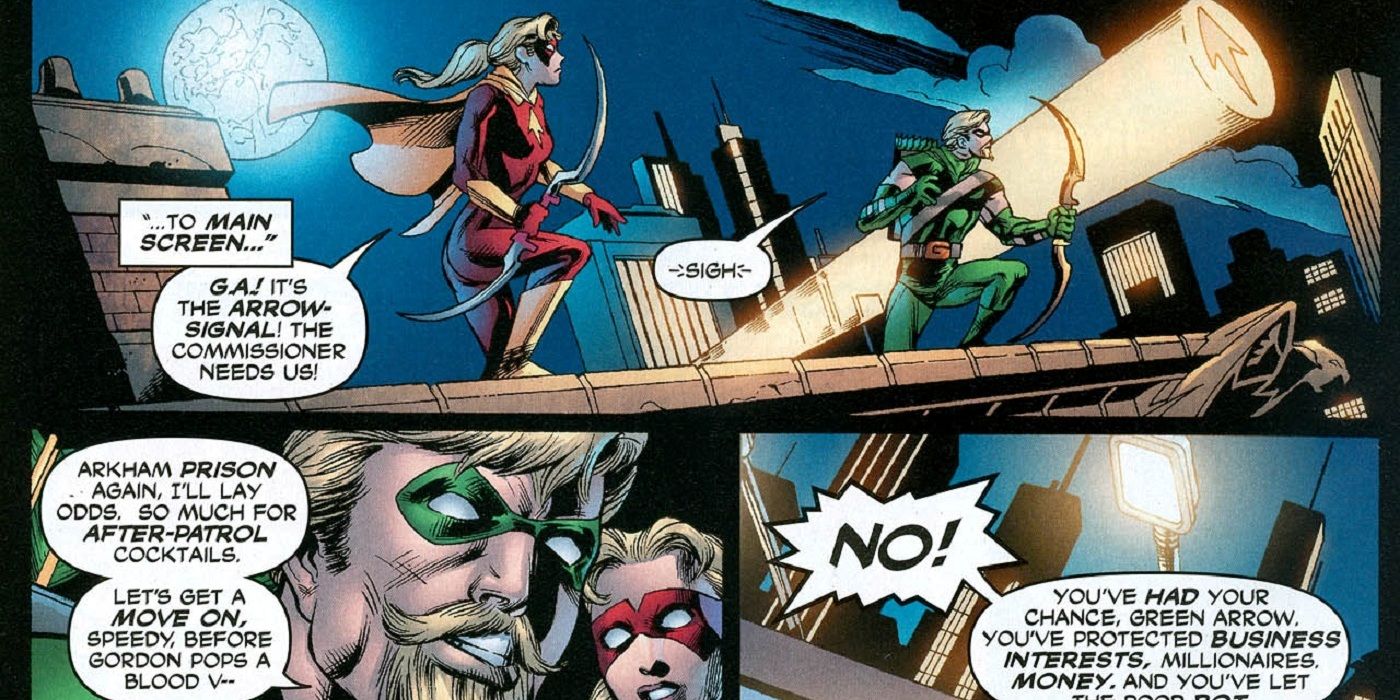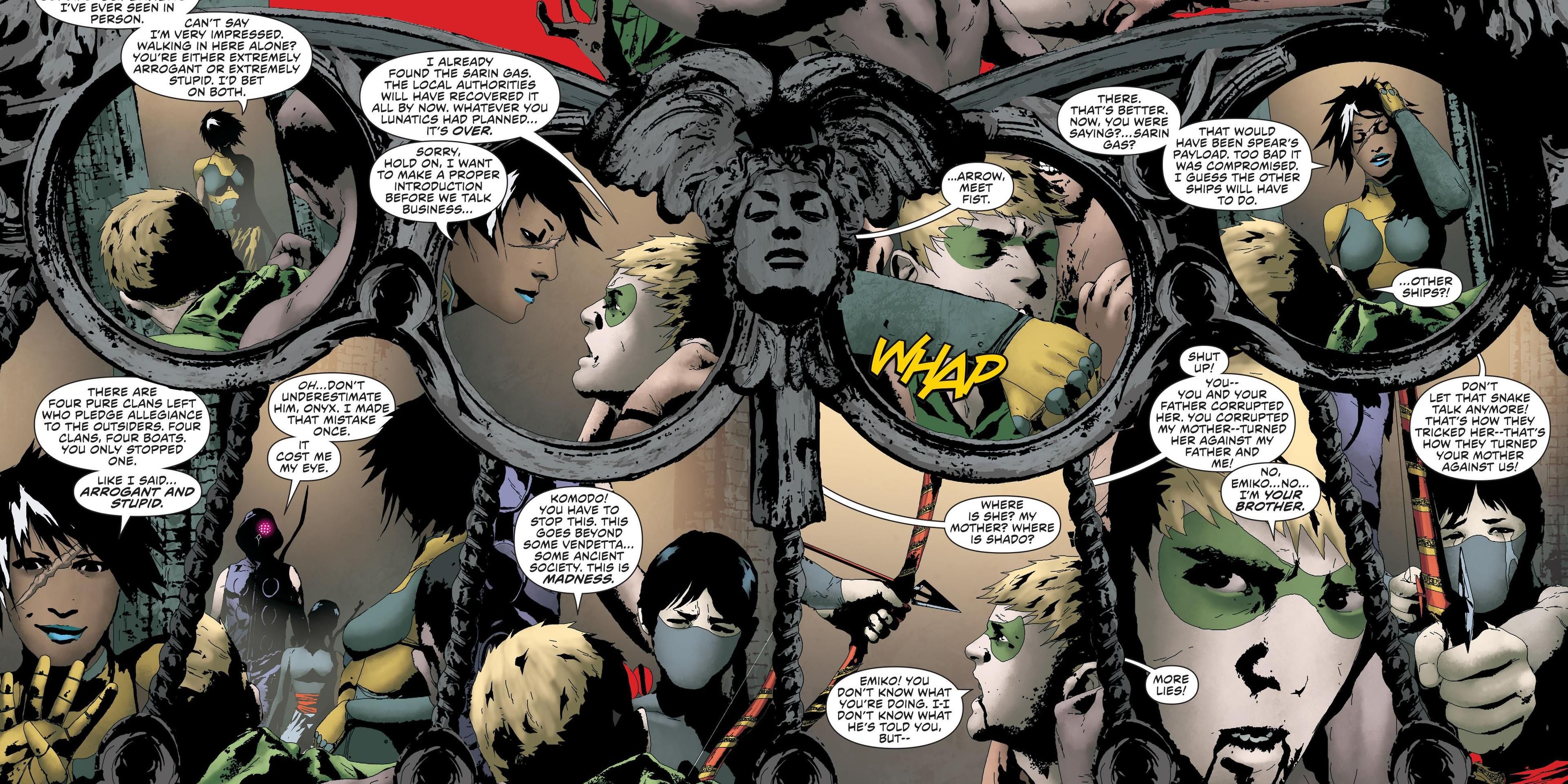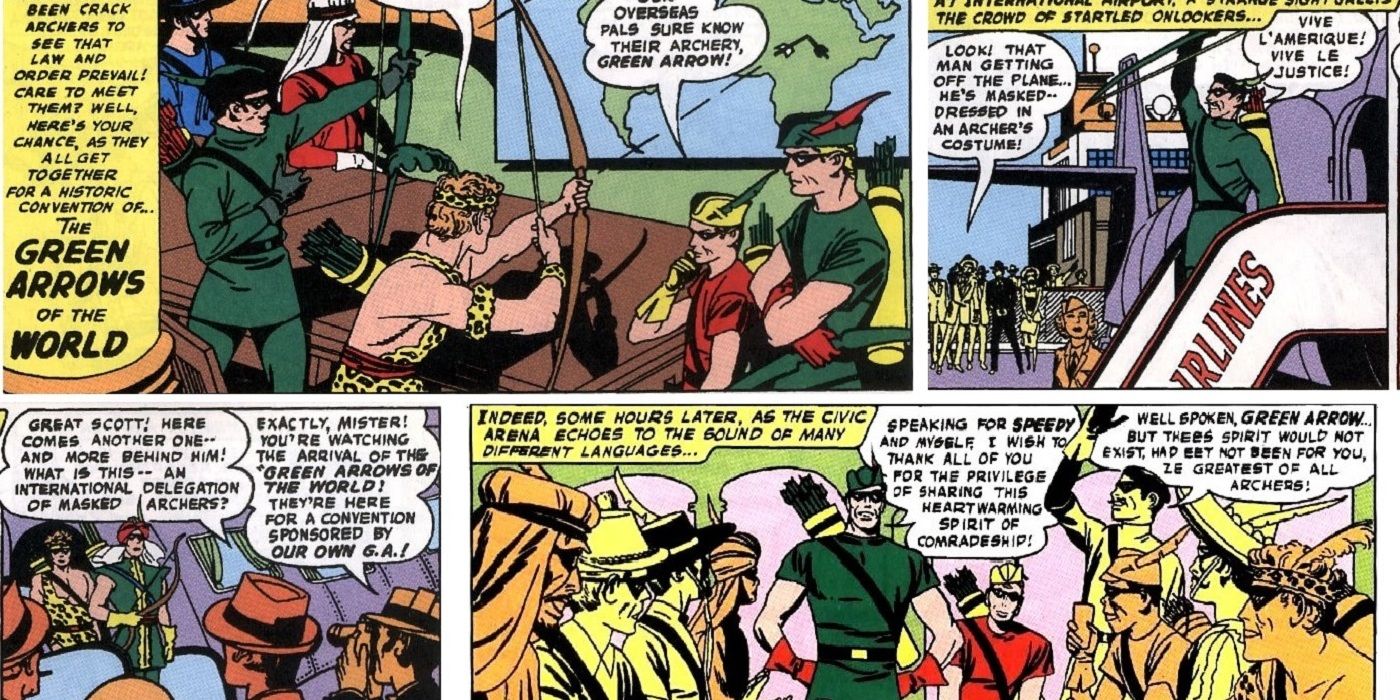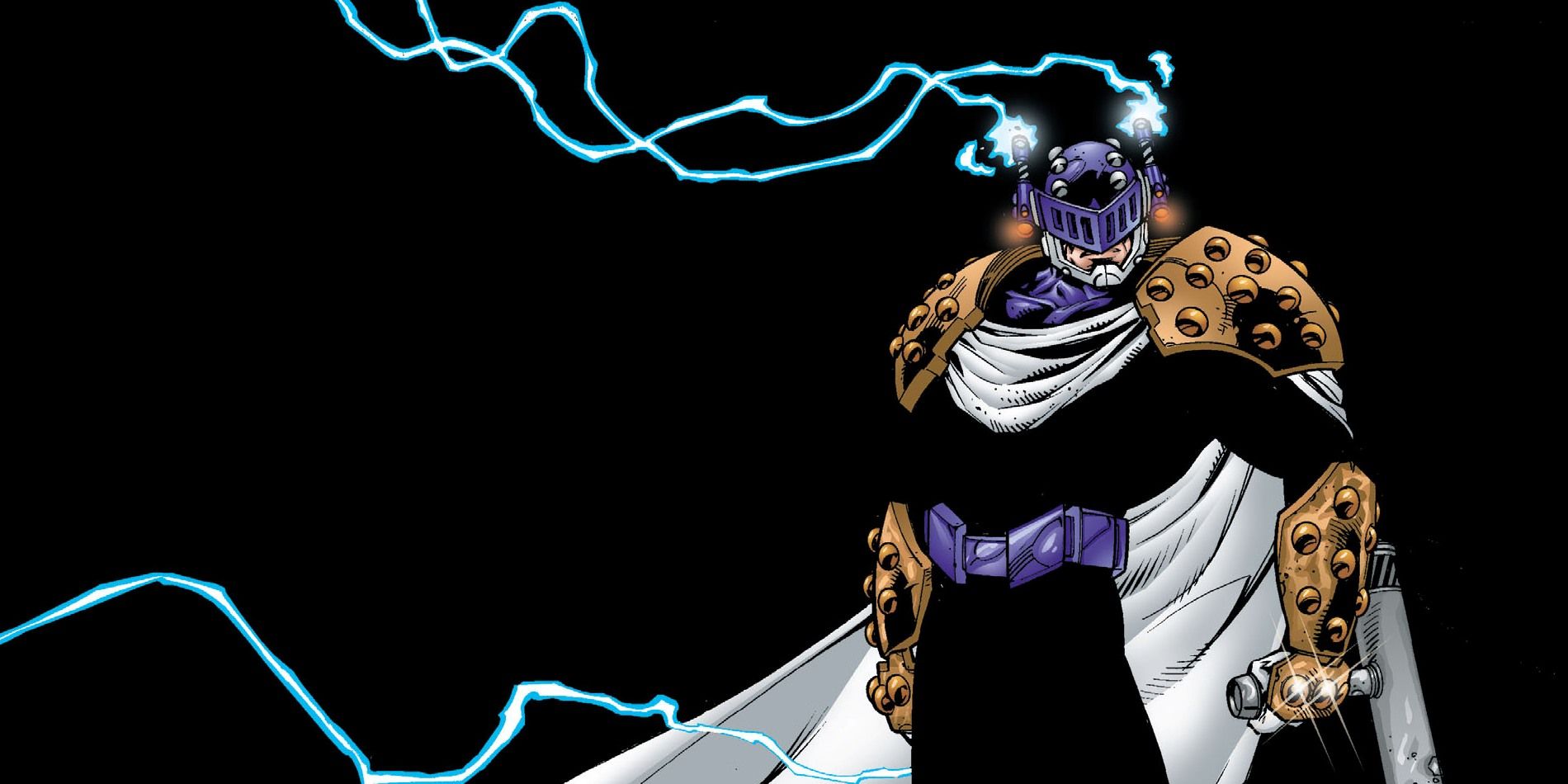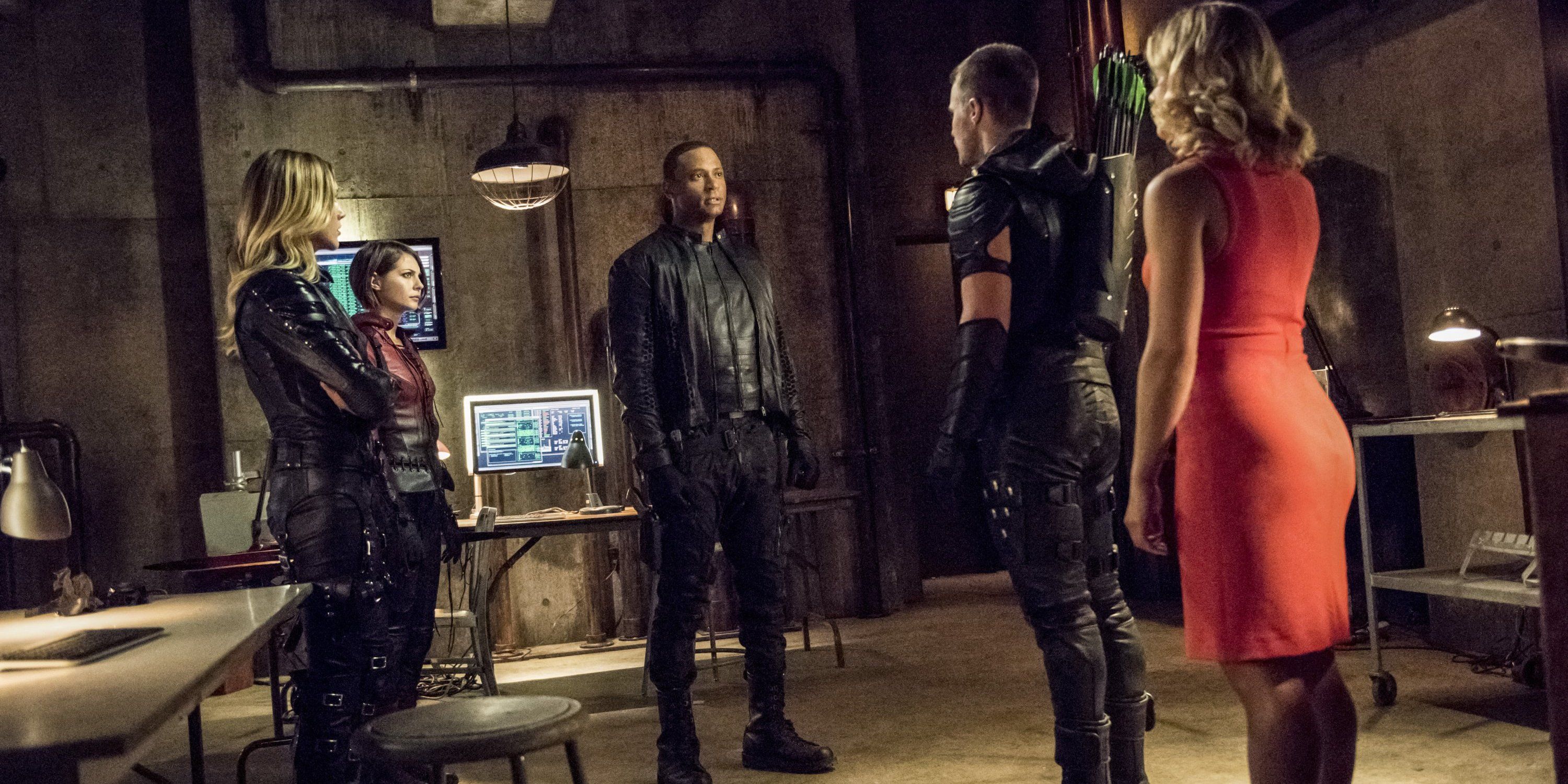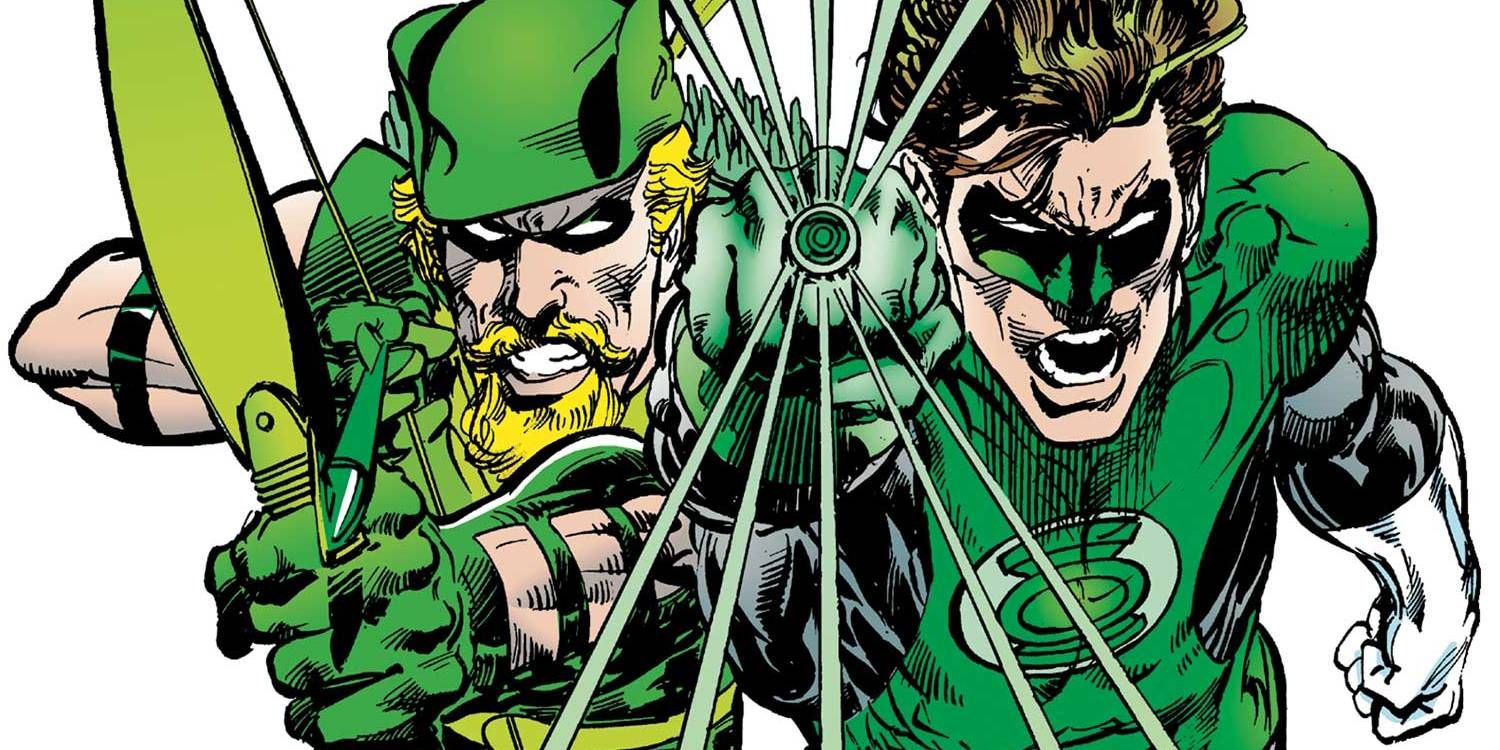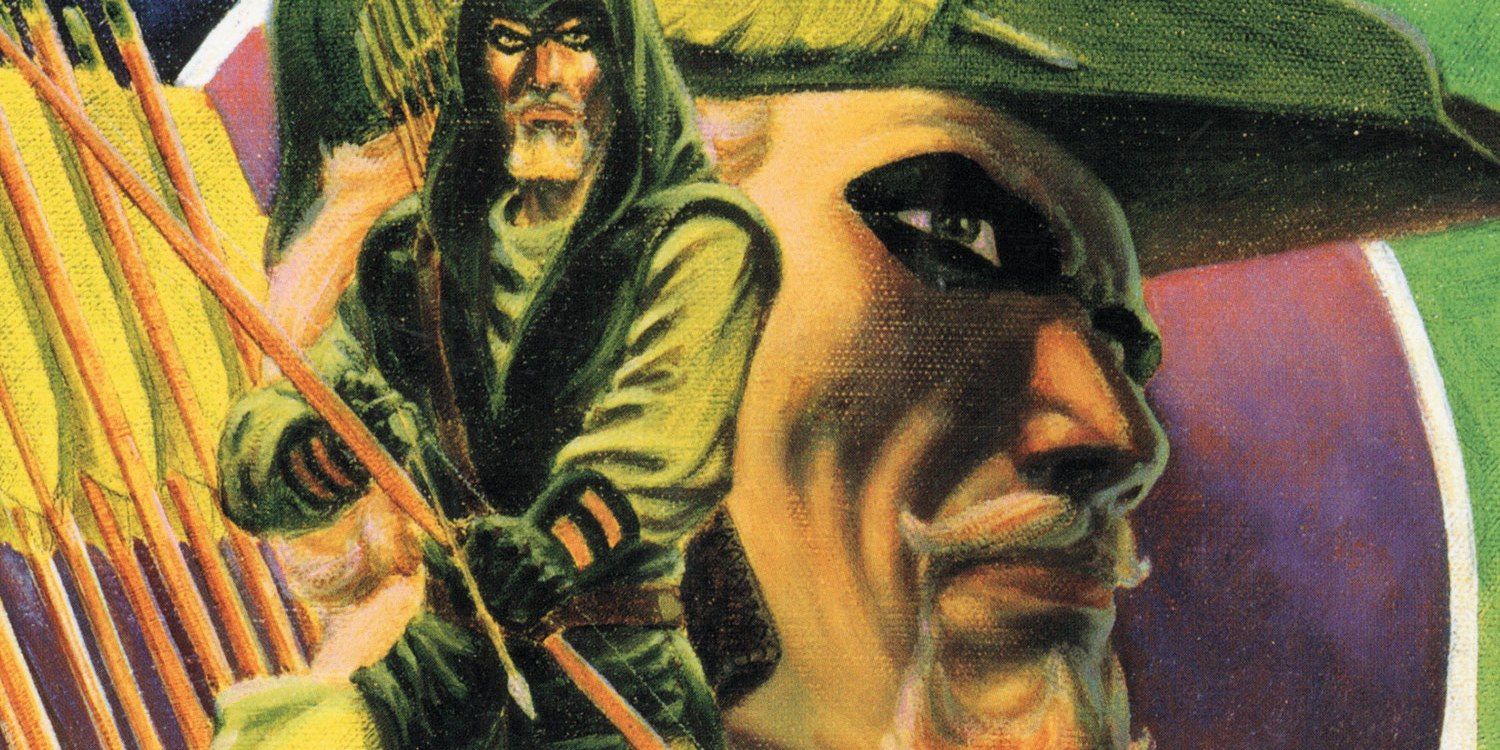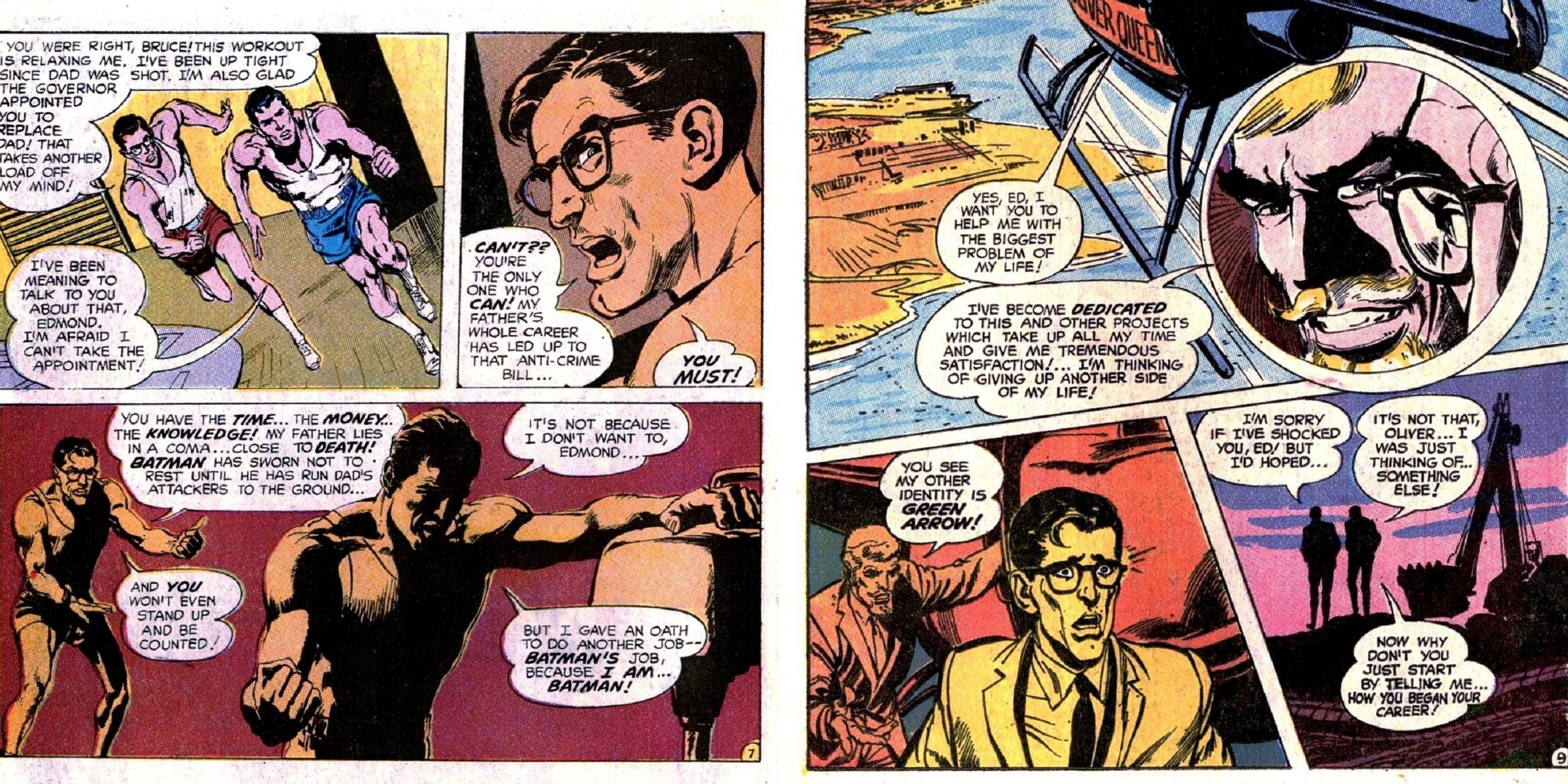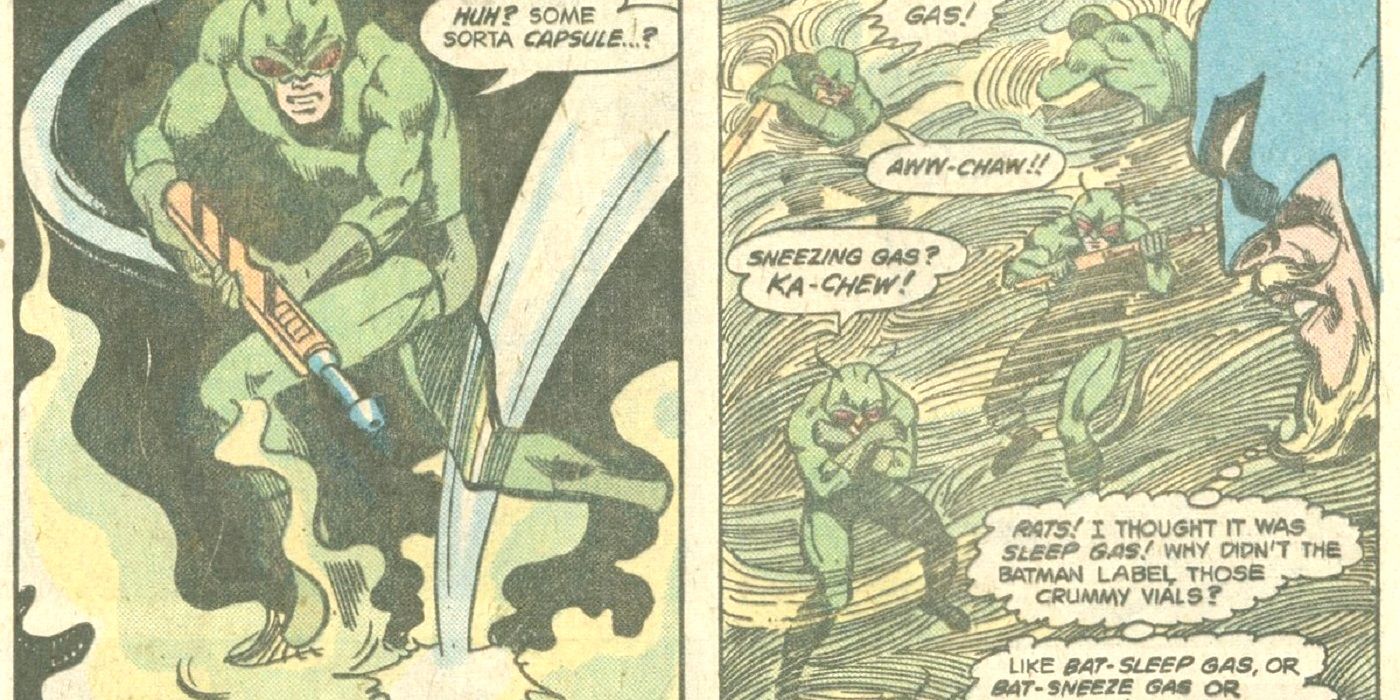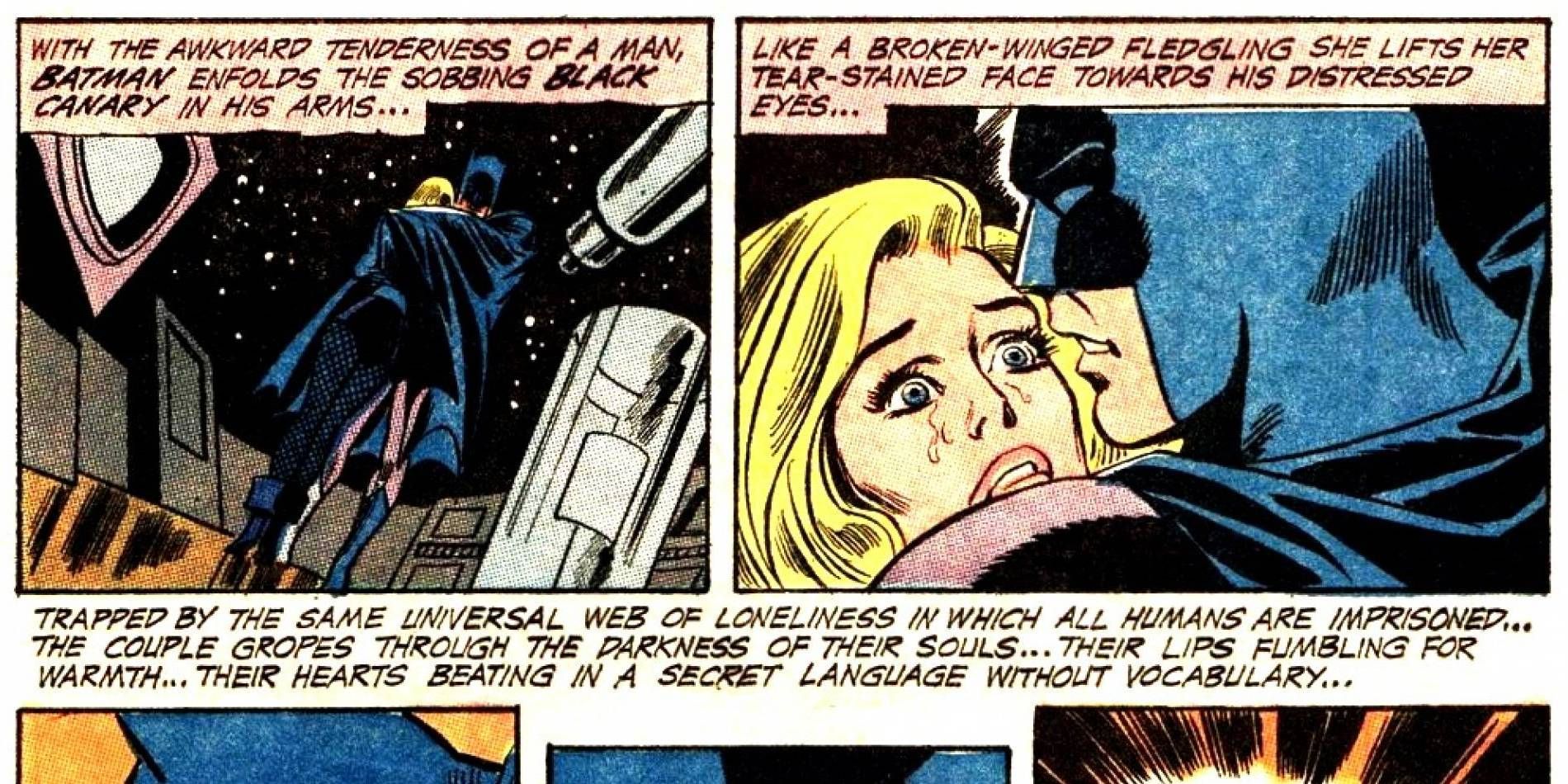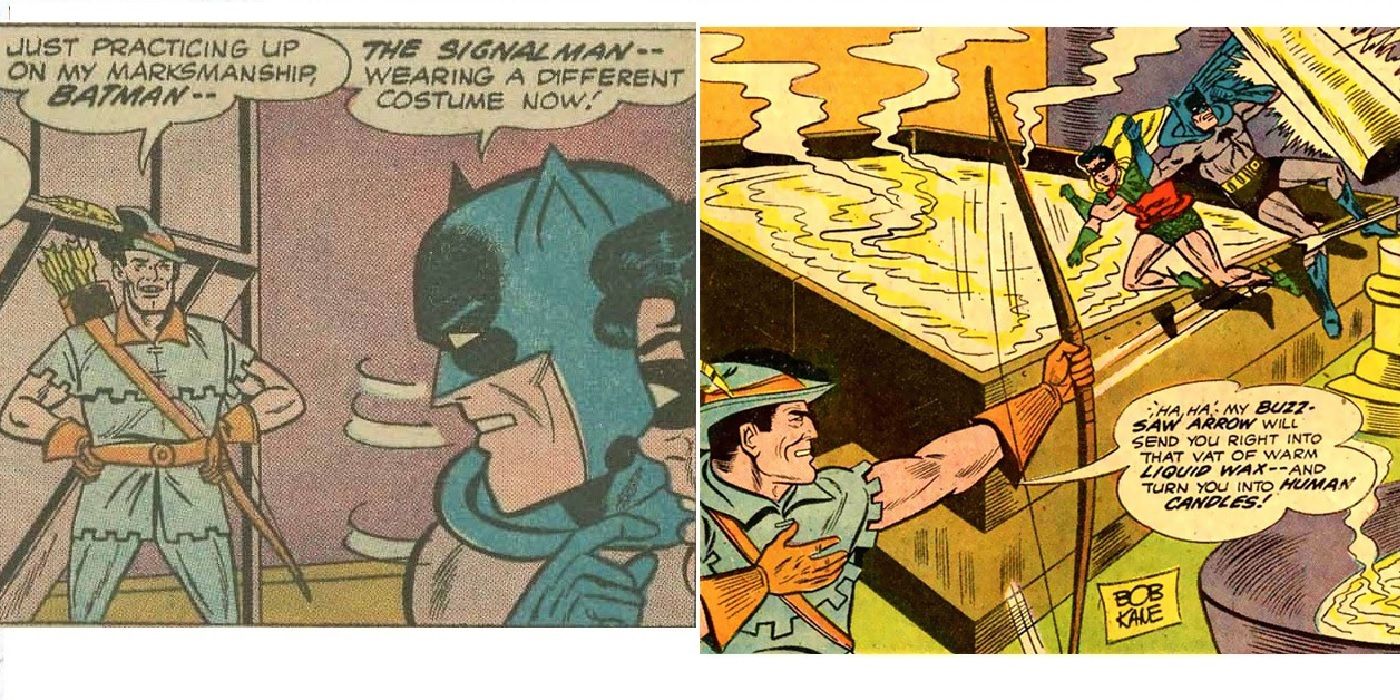Not only has Green Arrow been around for 75 years -- ever since Mort Weisinger and George Papp created him for November 1941's "More Fun Comics" #73 -- he's been visible in one book or another for most of that time. Of course, many of Green Arrow's trappings have borne a certain similarity to another longstanding DC character who (with his kid sidekick) used his wealth to make fantastic gadgets and powerful vehicles.
RELATED: Yoink! 20 Blatant Comic Book Rip-Offs
In a way, it's understandable. After all, Batman copied Superman somewhat during the '50s and '60s, with Ace the Bat-Hound, Bat-Mite and Batwoman following Krypto, Mr. Mxyzptlk and Supergirl. Therefore, in the spirit of good-natured ribbing, here (in no particular order) are 15 ways Green Arrow was... let's say inspired by Batman; and one where the Caped Crusader returned the favor.
17 Arrowcar, Arrowplane, etc.
One of the more obvious instances of pilfered branding involves Green Arrow's signature vehicle. The Arrowcar first appeared in November 1941's "More Fun" #73, several months after the term "Batmobile" was first used (in February 1941's "Detective Comics" #48). Although Batman used a distinctive roadster in his very first appearance (May 1939's "Detective" #27) and unveiled a Batplane not long afterwards ("Detective" #30), it took a while for the Batmobile to come into its own. Regardless, it's safe to say both Bat-vehicles preceded the Arrowcar and Arrowplane.
By the way, it looks like the Arrowcave may have predated the Batcave by at least a year or so. Until August-September 1942's "Batman" #12, which mentioned "secret underground hangars," the Dark Knight Detective kept his vehicles in a nondescript barn, which connected to Wayne Manor via an underground tunnel. The Batcave didn't make its official debut until 1943, when it appeared in both the "Batman" movie serial and the newspaper strip. By contrast, the Arrowcave (located under Oliver Queen's mansion, naturally) goes back to GA's debut in November 1941.
16 Teen Titans
Roy "Speedy" Harper also appeared first in "More Fun" #73, almost a year and a half after Robin the Boy Wonder became the Sensational Character Find of 1940 in "Detective Comics" #38. Lots of superheroes had kid sidekicks in the Golden Age, from Captain America and the Human Torch to the Sandman and Crimson Avenger. In the Silver Age, both Robin and Speedy were Teen Titans, although it took Speedy a while to join the group officially.
In the 1970s and '80s, while Dick Grayson was going to college and developing into Nightwing, Roy was kicking a heroin habit, playing guitar in the band Great Frog, joining federal anti-drug task forces and fathering a child with international assassin Cheshire. Except for the band, you can say that these were story-specific plot elements which make the character look more well-rounded in hindsight; but Roy's career does seem more colorful than Dick's.
15 Bull's Eye (No, Not That One)
Bull's Eye, aka Leapo the Clown, first appeared in September 1946's "World's Finest Comics" #24, about six-and-a-half years after the Joker's debut in Spring 1940's "Batman" #1. Other than sharing a theme, the two villains weren't all that similar. Originally, the Joker was a scary, cold-blooded thief who planned elaborate and unstoppable murders. By the time Bull's Eye came along, superhero comics had softened their collective tone enough that Green Arrow's foe was just a guy in a clown suit with a decent sense of humor (and a bullseye on his back).
Bull's Eye's short but prolific career consisted basically of 10 stories spanning 2 ½ years, from September 1946 to March 1949. One suspects that he hasn't been brought back because DC seems to be pretty satisfied with just a few clown-based supervillains. When you go from the Joker and Harley Quinn to the likes of Punch & Jewelee, that's a pretty steep drop-off.
14 Billionaire Boy's Club
As with the kid sidekick and the high-tech car, being a rich playboy was pretty standard for the Golden Age's street-level superheroes. The Green Hornet, the Crimson Avenger, the Sandman and the Shadow were all independently wealthy, and Oliver Queen was no different. Indeed, Ollie held onto his fortune well into the Silver Age, until writern Denny O'Neil and penciller Dick Dillin bankrupted him in November 1969's "Justice League of America" #75. In fact, this came a few months after Green Arrow's redesigned costume first appeared in "Brave and the Bold" #85 (August-September 1969), courtesy of artist Neal Adams and writer Bob Haney.
Taking away Ollie's wealth not only distinguished him further from Batman, it gave him a new social consciousness, which went on to define the character for the next few decades. The New 52 reboot made Ollie rich again (via his company Q-Corp) and repositioned him as a different kind of billionaire than the head of Wayne Enterprises.
13 Arrow's Globetrotting Training
The notion that Bruce Wayne spent several years traveling the world learning from various experts is a fairly recent addition. It wasn't really part of the Bat-mythology until 1986-87's "Batman: Year One;" and from there it became a big part of "Batman Begins." Before that, Bruce basically finished his schooling while dabbling in the more esoteric disciplines necessary to become a creature of the night. By contrast, of course, Oliver Queen became an ace archer while stranded on an uncharted island (but not after a three-hour tour).
We might quibble about whether this is really an "inspiration" situation, since every version of Ollie's origin has him stranded on that island, teaching himself archery and then using those skills to capture some seafaring criminals. All this arguably made him more sequestered during his training (and farther from his home base) than Bruce Wayne was during his. Even so, flashbacks which show Ollie leaving the island for places like Hong Kong and Russia seem like knowing nods to Bruce's journeys. Having Ollie missing and presumed dead also hearkens back to a similar plot point in "Batman Begins."
12 Heir To The Demon
Denny O'Neil and Neal Adams introduced immortal ecoterrorist Ra's al-Ghul in June 1971's "Batman" #232. He appeared periodically in "Batman" four more times in the next year-and-change, as part of an arc which culminated in that desert swordfight (September 1972's "Batman" #244). Over the next few decades, various creative teams used him sporadically but judiciously, including Mark Waid and Howard Porter in the 2000 "JLA" arc "Tower of Babel," and Chuck Dixon and Greg Land in a five-issue 2001 "Birds of Prey" arc. Still, as far as we can tell, he's never squared off against Green Arrow in the comics; although he wooed Black Canary in those "Birds of Prey" issues. Of course, Ra's was "Batman Begins'" main villain.
Similarly, Ra's and the rest of the League of Assassins (including Ra's' daughter Nyssa) fought Ollie and company during "Arrow's" third season (2014-15). Neither "Batman Begins" nor its sequels introduced the Lazarus Pit, but "Arrow" did. It also characterized "Ra's al-Ghul" as a title, not a proper name. Therefore, various people (including Ollie and Malcolm Merlyn) could "be" Rā's through the ages, augmenting his ageless reputation. Now "Arrow" is getting ready to introduce Talia al-Ghul, one of Batman's perennial romantic partners.
11 Gotham City's Ace Archers
In the year-long weekly miniseries "Trinity" (2008-09), writer Kurt Busiek and artist Mark Bagley (along with assorted collaborators) crafted an epic tale about Superman, Batman and Wonder Woman being erased from DC history and "reimagined" as gods. Accordingly, the miniseries' middle third took place in this altered timeline, where different sets of heroes protected Metropolis, Gotham and Washington, D.C. Naturally, subbing for Batman and Robin were Green Arrow and Speedy (Mia Dearden). They reported to Commissioner Gordon, hauled crooks to Arkham Prison and even responded to an Arrow-Signal (which, like the Arrowcar and Arrowcave, actually goes back to the Golden Age Green Arrow).
As it happens, in this timeline Green Arrow and Speedy had a reputation for favoring the upper class, which naturally was the opposite of Ollie's outspoken liberalism. Therefore, they ended up being challenged by another dynamic duo, Ragman and his sidekick Tatters. Ragman even tells Green Arrow "you have failed," but sadly doesn't specify "this city."
10 Outsiders
While Green Arrow and Batman both quit the Justice League rather loudly in the 1980s, Ollie did it first, in "Justice League of America" #181 (August 1980). In fact, by the time Batman quit three years later, Green Arrow had already rejoined (in March 1982's "JLA" #200). Of course, Batman ended up forming his own super-team, the Outsiders (starting in August 1983's "Batman and the Outsiders" #1). It included Black Lightning and Metamorpho, two heroes who had already rejected JLA membership. In various forms, the Outsiders' title ran for five years (1983-88) and was revived in the '90s (1993-95) and '00s (2007-11). During one of the later incarnations, Green Arrow both joined and gave the team financial support.
In the New 52, Green Arrow ran up against a group of unrelated "Outsiders." These made up a secret society dedicated to various weapons-related clans (Arrow, Sword, Spear, Axe, Shield, Fist and Mask). Each clan had a symbolic relic or totem which was supposed to bestow immortality and enlightenment on its holder. Ollie's father Robert was once head of the Arrow Clan; and Katana's Soultaker sword is its clan's relic. These Outsiders had fallen into corruption, so Green Arrow rejected them and destroyed the Arrow Clan's green totem.
9 Green Arrows Of The World
Debuting in January 1955's "Detective Comics" #215, the "Batmen of All Nations" was one of the 1950s' more durable Bat-concepts. A loosely-affiliated group made up of various Batman-inspired (if not bat-themed) crimefighters from around the world, it included Great Britain's Knight and Squire (from 1950's "Batman" #62), Italy's Legionary, Argentina's Gaucho and Sweden's Wingman (from 1951's "Batman" #65). Later, the group added Superman and started calling itself the Club of Heroes. Grant Morrison and J.H. Williams III revived the group ("Batman" #667-69, August-November 2007) as a forerunner for Batman Incorporated.
In its way, Green Arrow's version was more diverse; and it boasted art by Jack Kirby. "The Green Arrows of the World" (July 1958's "Adventure Comics" #250) introduced Green Arrows from Mexico, Polynesia, Japan and Switzerland; as well as the Phantom (France), the Bowman from Britain and the Bowman of the Bush (from Africa). Unlike its predecessor, the GAOTW -- aka, the International Delegation of Masked Archers -- seems to have been a one-time thing. That's too bad, because especially during the social-activism years, we'd have enjoyed seeing Ollie reconnect with one of his multicultural counterparts.
8 Prometheus
Grant Morrison created Prometheus -- the son of criminals who saw his parents gunned down by police -- to be an anti-Batman, capable of beating every Justice Leaguer including the Dark Knight. He first appeared in a one-off special from February 1998 (published on New Year's Eve 1997) and fought the League the next month, starting in "JLA" #16-17 (March-April 1998). Prometheus returned for Morrison's final JLA arc, 2000's "World War III."
After that, Prometheus appeared in "Batman: Gotham Knights" in 2004-05 and "Birds of Prey" in 2006; but this turned out to be an impostor. The real Prometheus murdered him, but was himself killed by Green Arrow at the end of the "JLA: Cry For Justice" miniseries (2009-10). Prometheus had orchestrated the destruction of Star City, which among other things, killed Lian Harper, Roy Harper's daughter. Prometheus can be seen currently on "Arrow," where it looks like he's this season's main villain.
7 Tough Love
While Batman and Robin have been together since 1940, for a long time the Dynamic Duo didn't have many other associates. That all started to change in the '90s, when Batman, Nightwing and Oracle were joined by Azrael, Huntress, Batgirl II (Cassandra Cain) and Robin IV/Batgirl III (Stephanie Brown). Others have come and gone, but now "Detective" is pretty much a team title. By contrast, in the comics, Green Arrow tended to pal around with some combination of Speedy, Black Canary and Green Lantern. Eventually, comics' Team Arrow included Ollie, Black Canary, Roy Harper (since graduated to Arsenal/Red Arrow), Connor Hawke (Green Arrow II) and Mia Dearden (Speedy II).
TV's Arrowcave is more crowded, with Felicity Smoak, John Diggle and four new recruits (Ragman, Artemis, Wild Dog and Mr. Terrific) replacing Arsenal, White Canary (Sara Lance), Black Canary and Speedy (Thea Queen). There are also guest heroes like the Flash or the Atom, plus allies like Lyla and Nyssa. Like Batman, TV's Ollie has been managing his associates with some combination of scowling, yelling and (eventually) more positive feedback. Batman got more mellow as the years went by, and it looks like Ollie will too.
6 The O'Neil/Adams Connection
Denny O'Neil and Neal Adams first teamed up on a Batman story with January 1970's "Secret of the Waiting Graves" in "Detective Comics" #395. Their moody, gothic approach gave Batman a new sense of heightened realism and redefined the character for an entire generation of readers. A few months later, when the pair took over "Green Lantern" with April 1970's issue #76, they paired Green Arrow with the Emerald Gladiator for a short-lived but even more influential series of socially-conscious stories.
O'Neil and Adams tackled overpopulation, housing inequality, Native American rights, racism, corrupted courts, drug use and environmental issues as they took the pair across America and to distant planets. Both collaborations were landmarks, and both produced some excellent comics. However, while the Batman stories represented a creative team at the height of its powers bringing out the best in a 30-year-old feature, the Green Lantern/Green Arrow stories were much more personal, speaking to concerns the two creators had about the state of their country and the world itself. No one can deny that O'Neil and Adams changed Batman and Green Arrow for the better, but we'd argue that the GL/GA run helped change comics itself for the better.
5 The Prestige (Format, That Is)
Speaking of indelible influences on longstanding characters, Frank Miller's "The Dark Knight Returns" (1986) shook up the Bat-status quo as much as, if not more than, O'Neil and Adams' early-'70s stories. Its tale of an aging Caped Crusader coming out of retirement for (as far as anyone knew) one last series of adventures was told in four double-sized issues. However, they were presented in a new format, which was squarebound like a graphic novel but sized like an ordinary comic. At $2.95 an issue, it also aimed to be more affordable than a regular-sized graphic novel. Initially, DC didn't know what to call this new format, since "DKR" was the only title using it. However, for the second such series, DC dubbed it the "Prestige Format."
That series, of course, was Mike Grell's three-issue "Green Arrow: The Longbow Hunters" (1987), which itself redefined the Emerald Archer to fit better with the grim 'n' gritty 1980s. The Prestige Format soon became ubiquitous in the subsequent years, presenting one-offs and miniseries on high-quality paper between two sturdy covers. It went unnamed until the "Longbow Hunters" miniseries, but Batman still used it first.
4 Parallel Subplots
"The Senator's Been Shot" (in "Brave and the Bold" #85, 1969) is typical of Bob Haney's gonzo "B&B" tenure. After the titular shooting, the state's governor wants to appoint Bruce Wayne instead of the senator's preference, his son Edmond. Although Bruce wants the senator's anti-crime bill to pass, he's also after mobster Miklos Minotaur. Meanwhile, Ollie -- who's considering ending his Green Arrow career -- is competing with Minotaur on a big land development deal. When Minotaur bombs Ollie's building and steals the plans for the project, Green Arrow swings reluctantly into action.
Later, Bruce tells Edmond he can't become a senator... because he's Batman! Edmond then meets Ollie about the building project, but Ollie says he might stop being Green Arrow! The rest is rapid-fire plotting: Ed is kidnapped; Bruce is sworn in; the heroes rescue Ed and arrest Minotaur; Bruce casts the deciding vote; the Senator recovers; Ollie accepts being Green Arrow; Ed erases his memories of their secret identities.
Now, it's probably a coin-flip that Bruce tells Ed his secret just before Ollie does the same. (As Ed muses, "Amazing coincidence!") Still, it is another instance of Green Arrow following Batman's lead. Ironically, in a story devoted to accepting responsibility, Ed never takes his dad's Senate seat.
3 Green Arrow vs. 1970s Metacommentary
The two-parter from "World's Finest Comics" #248-49 (December 1977-March 1978) is one of our all-time favorite Green Arrow stories. Written by Gerry Conway, pencilled by Trevor Von Eeden and inked by Vince Colletta, it brings back John DeLeon, the financier who stole Ollie's fortune. He's made a deal with Hellgrammite (yet another villain who fought Batman first, in "B&B" #80) regarding an eternal-youth scam, but everything went south and he wants Ollie's help. See, he's been to the cave under Ollie's mansion and seen what it was used for, and realized that... Oliver Queen is Batman!
With Ollie's regular costume and arrows destroyed in a Hellgrammite battle, and Black Canary kidnapped by the supervillain, Ollie has no choice but to put on the Bat-costume -- complete with fully-loaded utility belt -- which DeLeon appropriated from a police museum. Even when Ollie gets his spare bow and arrows, his disgust and his unfamiliarity with the Batsuit provide a lot of funny moments. (At one point DeLeon realizes that "Batman" still has Ollie's beard, to which Ollie replies, "It's a disguise!") DeLeon dies at the end, allowing the story to bring some closure to a long-running subplot, as well as hang a very entertaining lantern on the Bat-similarities.
2 Turn-a-Bat Is Fair Play, Part 1: Black Canary & Batman
Green Arrow and Black Canary's romance is one of superhero comics' most storied, but at the beginning it took a bit of a swerve. Brian Cronin has all the details. In 1970, Black Canary was an Earth-Two heroine who had shown up in the Silver Age as part of the revived Justice Society. She appeared in a few JLA/JSA team-ups before migrating to Earth-One in 1969, after her husband Larry's death. Denny O'Neil was writing "Justice League of America" then and began developing her romance with Green Arrow.
In July 1970's "Green Lantern" #78 O'Neil and Neal Adams established that she was in love with Ollie. After that, though, Black Canary and Batman shared a brief -- and somewhat jarring -- romantic interlude aboard the JLA Satellite in "JLA" #84 (November 1970). She's alone on the satellite doing monitor duty when he shows up to relieve her, they talk about him being a playboy and he reveals he "couldn't" marry the only one he ever wanted to. Against the backdrop of her late husband and his well-hidden loneliness, they kiss briefly and never speak of it again. Therefore, we might characterize this (however loosely and inappropriately) as Batman following Green Arrow.
1 Turn-a-Bat Is Fair Play, Part 2: The Blue Bowman
This last one is more on-point (sorry). Created by Bill Finger and Sheldon Moldoff for "Batman" #112 (December 1957), Signalman's sinister motif was signs, signals and symbols. He appeared again two years later, in issue #124. However, in issue #139 (April 1961), he changed themes completely, wielding trick arrows as the Blue Bowman. Why such a sudden shift? Well, it turns out that Phil "Signalman" Cobb met Arrow's old foe Bull's Eye in prison, and Phil realized Batman wouldn't know how to fight a guy who used trick arrows. This might not have been the best reasoning, since Green Arrow had been around for a while (even in the context of the comics). Indeed, in the same month as the Blue Bowman's debut, Green Arrow was joining the Justice League ("JLA" #4, March-April 1961).
Anyway, Phil's one appearance as the Blue Bowman was decent, if predictable. He trapped Batman and Robin in giant blobs of wax -- which we presume is a fetish for someone -- but they escaped; he was captured and stuck to the Signalman identity thereafter. The Blue Bowman wasn't forgotten, though; he showed up in the "Batman: The Brave and the Bold" cartoon as the evil-universe version of Green Arrow.
What else connects Green Arrow and Batman? Let us know with a comment!

